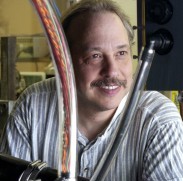Featured Stories | January 24, 2014
Deeper Submergence: WHOI Launches the Center for Marine Robotics
By Genevieve Wanucha
Oceans at MIT talks with Dana Yoerger of Woods Hole Oceanographic Institution (WHOI) about the ambitious plans of the new Center for Marine Robotics, which include further collaborations with MIT and autonomous vehicles that can work under Arctic ice.
Woods Hole Oceanographic Institution (WHOI) scientists and their underwater vehicles have accomplished some of the great feats of marine robotics: discovering the Titanic wreck, mapping the Earth-encircling Mid-Atlantic Ridge system, and assessing the impact of oil spills on deep sea ecosystems, to name just a few. Now, in keeping with its entrepreneurial spirit, WHOI has launched the Center for Marine Robotics (CMR) in an effort to accelerate the application of newly emerging robotic technologies to ocean science problems.
The CMR will link WHOI investigators, and their collaborators at such places as MIT and John’s Hopkins University, with non-traditional sources of funding from industry and government, along with continued philanthropy. “The new alliances will open the doors to fundamental research into how humans and robots can better work together to solve complex problems in scientific or industrial contexts,” says Dana Yoerger (MIT Dept. Mechanical Engineering SB ’77, SM ’79, PhD ’82), Senior Scientist at WHOI and member of the Deep Submergence Laboratory, who currently serves as the CMR’s interim director.
The Deepwater Horizon Oil Spill in 2010 was a major impetus for the formation of the CMR. “At the time, we asked ourselves what a small scientific institution could contribute to these kinds of disasters when oil companies command vast resources in terms of operational capabilities,” says Yoerger. “The answer was a lot. We could help a great deal because of our unique tools, sensors, underwater vehicles, and most importantly, expertise that can’t be found elsewhere. That experience woke us up to the potential for robotic research in worlds outside of the traditional funding base.”

The need for WHOI’s robotics expertise in industry is growing as new transportation routes and oil and gas development creates the potential for troublesome oil spills under Arctic ice. The first step will be to design unmanned robotic vehicles that can operate safely under thick ice and send back video. An unprecedented challenge for humans, the endeavor requires underwater navigation at high latitudes and communications over long distances in unfriendly acoustic environments.
The CMR will advance under-ice projects already underway at WHOI, such as a new polar remotely operated vehicle (PROV) designed to send up to 12 miles under sea ice while transmitting high-definition video images via a fiber-optic link. Beyond the industrial context, the CMR aims to expand the opportunities of scientists to apply these new technologies to basic science questions related to ice dynamics, ice formation and melting, and the changing ocean ecosystems in a warming Arctic.
The CMR is also powering collaborations with robotics departments at MIT. For example, Yoerger and John Leonard, Professor of Mechanical and Ocean Engineering at MIT and leader of the Marine Robotics Group, are drawing up plans for underwater vehicles with dramatically improved ability to work in complicated environments, inspired by the MIT autonomous car that competed in the DARPA Grand Challenge in 2007. The CMR’s vehicle will be designed to perform sophisticated tasks on the ocean floor, such as monitoring the safety of oil installations while avoiding getting tangled up in the valuable structures. “It’s very clear if autonomous robots are going to work in complex environments, they are going to have to be a whole lot smarter than the underwater robots we have now,” say Yoerger, who notes that the autonomy project will combine the strengths of MIT and WHOI in fundamental ways.
The people behind the CMR include David Mindel (MIT PhD ’96), MIT Professor Aeronautics and Astronautics and Director of the Laboratory for Automation Robotics and Society at MIT; Hagen Schempf (MIT/WHOI PhD ’90), Principal Systems Scientist at Carnegie Mellon Robotics Institute and Director of the Hazardous Environments Robotics Lab; James Cameron, Academy Award winning screen writer, director and producer and deep sea expedition leader, who recently bequeathed to WHOI the DEEPSEA CHALLENGER, the only human-occupied vehicle currently able to reach the deepest parts of the ocean; and retired Admiral Gary Roughead, the 29th Chief of Naval Operations, among others. With these forces combined, the opportunities in marine robotics may well grow as limitless as the sea itself.
So much to see!
Take a look: In January 2014, WHOI’s remotely operated vehicle Jason explored vent and seep sites on the East Pacific Rise at 9 North. This video compilation shows some of the organisms and seafloor habitats that the team on board the research vessel R/V Atlantis explored:






